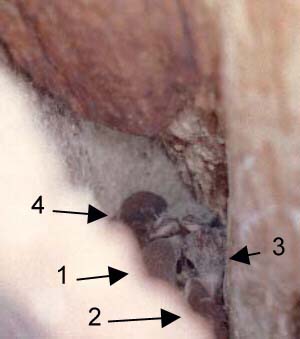American Kestral Nest With Baby Bird Photographs and Sound Recording
Photo by Greg Clark, July 5, 1999
 Usually a nest for American Kestral is located high up in a cavity in a saguaro cactus or tall dead pine tree. While atlasing in the White Mountains near Burton, Arizona, Tim Price found a most unusual nest. Instead of using a cavity inside the wood of a tree, the birds had selected the gap between the tree bark and the dead tree body. As a dead ponderosa ages, the bark separates from the smooth wood and eventually falls away. On this tree there is a gap of about 40 mm (1.5 inches) which is just enough for the baby birds. The top image shows two baby kestrals side by side. The black eye of one bird is pointed out with an arrow to help you orient how the birds are positioned. The bark on the left is covered in white wash and the pine tree wood is the natural light brown color. Besides the unusual location of the nest in the tree, the nest is only about 2 meters above the forest floor. Difficult to photograph, the camera was placed against the opening in the bark and the exposure made without really being to focus. Three birds could be seen in the cavity at the time the picture was taken. Another view was possible by using a hole in the bark located above the birds. This view is shown in the lower photo. After the lower photo was developed a fourth bird could be seen. Each bird is numbered to help you figure out where each bird's head is located. Birds 1, 2, and 3 have their heads together (you can clearly see an eye on bird 3 and part of bird 3's wings. An eye and the beak of bird 4 is visible but hard to discern. He is looking directly at the camera lens. The lower photo was taken with an estimated focus distance since focusing was not possible.
Usually a nest for American Kestral is located high up in a cavity in a saguaro cactus or tall dead pine tree. While atlasing in the White Mountains near Burton, Arizona, Tim Price found a most unusual nest. Instead of using a cavity inside the wood of a tree, the birds had selected the gap between the tree bark and the dead tree body. As a dead ponderosa ages, the bark separates from the smooth wood and eventually falls away. On this tree there is a gap of about 40 mm (1.5 inches) which is just enough for the baby birds. The top image shows two baby kestrals side by side. The black eye of one bird is pointed out with an arrow to help you orient how the birds are positioned. The bark on the left is covered in white wash and the pine tree wood is the natural light brown color. Besides the unusual location of the nest in the tree, the nest is only about 2 meters above the forest floor. Difficult to photograph, the camera was placed against the opening in the bark and the exposure made without really being to focus. Three birds could be seen in the cavity at the time the picture was taken. Another view was possible by using a hole in the bark located above the birds. This view is shown in the lower photo. After the lower photo was developed a fourth bird could be seen. Each bird is numbered to help you figure out where each bird's head is located. Birds 1, 2, and 3 have their heads together (you can clearly see an eye on bird 3 and part of bird 3's wings. An eye and the beak of bird 4 is visible but hard to discern. He is looking directly at the camera lens. The lower photo was taken with an estimated focus distance since focusing was not possible.
 The nest was watched closely by the female kestral while we photographed the babies. The male split as soon as Tim arrived and was not seen again. The female tried to take Tim's head off. A sound recording of the female is available for download.
The nest was watched closely by the female kestral while we photographed the babies. The male split as soon as Tim arrived and was not seen again. The female tried to take Tim's head off. A sound recording of the female is available for download.
Note that this bark nest technique is also used by Brown Creeper. An example of this can be found on this web site.
The original American Kestral sound recording was produced using a Sennheiser MKH70 shotgun microphone and the audio was stored on a 48 ksps DAT using a Tascam DA-P1 digital audio recorder. The recording was down-sampled to 44.1 ksps and converted to MPEG3 to reduce the file size.
download mpeg3 recording (fem_kest.mp3)
Copyright Greg Clark, 1999
update 8/2012